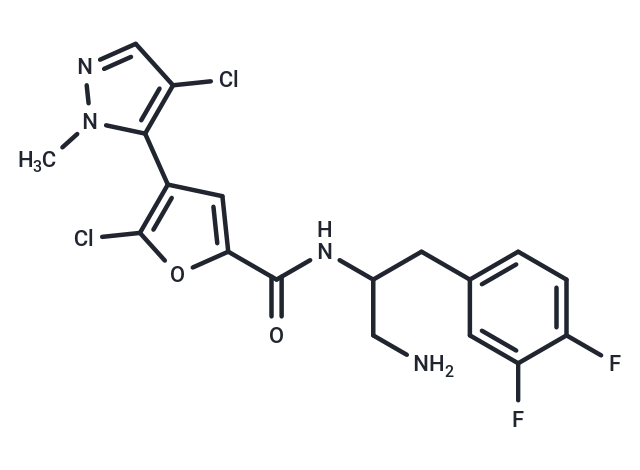Shopping Cart
Remove All Your shopping cart is currently empty
Your shopping cart is currently empty
Uprosertib (GSK2141795) is a potent, selective Akt broad-spectrum inhibitor with IC50 values of 180/328/38 nM for Akt1/Akt2/Akt3.

| Pack Size | Price | USA Warehouse | Global Warehouse | Quantity |
|---|---|---|---|---|
| 1 mg | $39 | In Stock | In Stock | |
| 2 mg | $54 | In Stock | In Stock | |
| 5 mg | $77 | In Stock | In Stock | |
| 10 mg | $126 | In Stock | In Stock | |
| 25 mg | $212 | In Stock | In Stock | |
| 50 mg | $340 | In Stock | In Stock | |
| 100 mg | $563 | In Stock | In Stock | |
| 200 mg | $791 | In Stock | In Stock | |
| 1 mL x 10 mM (in DMSO) | $110 | In Stock | In Stock |
| Description | Uprosertib (GSK2141795) is a potent, selective Akt broad-spectrum inhibitor with IC50 values of 180/328/38 nM for Akt1/Akt2/Akt3. |
| Targets&IC50 | Akt2:328 nM, Akt1:180 nM, ROCK2:1850 nM, Akt3:38 nM, ROCK1:1570 nM, CDK7:2100 nM |
| In vitro | METHODS: Lysates of a mixture of K562, COLO205, SKNBE2, and OVCAR8 cells were preincubated with 0, 2.5 nM, 25 nM, 250 nM, 2.5 μM, or 25 μM of the free compound Uprosertib (GSK2141795) for 45 min at 4°C on an end-to-end shaker. Subsequently, lysates were incubated with beads (coupled to Akt probes or kinobads) for 1 h at 4°C to perform qualitative and quantitative experiments. RESULTS Uprosertib inhibits kinobead binding. The IC50 value of Akt1 is 180 nM, the IC50 value of Akt2 is 328 nM, and the IC50 value of Akt3 is 38 nM; the KD value of Akt1 is 16 nM, the KD value of Akt2 is 49 nM, and the KD value of Akt3 The value is 5 nM. [1] METHODS: HAP1, HAP1 RNF43 KO, and HAP1 PWWP2B KO cells were treated with 10 μM Uprosertib for 48 hours, and the inhibitory effect of Uprosertib was evaluated using MTS assay and the effect on cell line viability was detected. RESULTS Uprosertib reduced cell viability in a dose-dependent manner. [2] METHODS: HCT116 and LS174T cell lines were treated with uprosertib (1 μM to 15 μM) for 72 h in the presence or absence of lactate (0-20 mM), and biomass was determined using the SRB assay; Cells were treated with uprosertib (5 or 10 μM) for 24 h and apoptosis was measured using the Caspase-Glo 3/7 assay. RESULTS Uprosertib induced dose-dependent cytotoxicity in both cell lines; uprosertib induced a dose-dependent increase in caspase-3/7 activation in HCT116 and LS174T cell lines. [3] |
| In vivo | METHODS: Uprosertib (GSK2141795) (10 mg/kg/day, oral) was used to study in vivo efficacy on the growth of MKN45 xenograft models. RESULTS Uprosertib significantly inhibited tumor growth at 3 weeks, with 27% inhibition in KMN45 xenografts. [2] |
| Kinase Assay | Selectivity profiling experiments: The lysates (5 mg of total protein each) are preincubated with 0 (DMSO control), 2.5 nM, 25 nM, 250 nM, 2.5 μM or 25 μM free compound (GSK690693 or GSK2141795) on an end-over-end shaker for 45 min at 4 °C. Subsequently, lysates are incubated with beads (coupled Akt probe or kinobeads) for 1 h at 4 °C, for both qualitative and quantitative experiments. The beads are washed with 1× CP buffer and collected by centrifugation. Bound proteins are eluted with 2× NuPAGE LDS sample buffer, and eluates are reduced and alkylated by 50 mM dithiothreitol and 55 mM iodoacetamide. |
| Cell Research | Cell lines are typically grown in RPMI 160 medium containing 10% FBS. Some cell lines are grown in media specified by the vendor. A 3-day proliferation assay using CellTiter-Glo is performed to measure the growth inhibition by the compounds at 0–30 μM. Cell growth is determined relative to untreated (DMSO) controls. EC50's are calculated from inhibition curves using a 4- or 6-parameter fitting algorithm in the Assay Client application.(Only for Reference) |
| Synonyms | GSK795, GSK2141795 |
| Molecular Weight | 429.25 |
| Formula | C18H16Cl2F2N4O2 |
| Cas No. | 1047634-65-0 |
| Smiles | Cn1ncc(Cl)c1-c1cc(oc1Cl)C(=O)NC(CN)Cc1ccc(F)c(F)c1 |
| Relative Density. | no data available |
| Storage | Powder: -20°C for 3 years | In solvent: -80°C for 1 year | Shipping with blue ice/Shipping at ambient temperature. | |||||||||||||||||||||||||||||||||||
| Solubility Information | H2O: < 1 mg/mL (insoluble or slightly soluble) Ethanol: 76 mg/mL (177.05 mM), Sonication is recommended. DMSO: 65 mg/mL (151.43 mM), Sonication is recommended. | |||||||||||||||||||||||||||||||||||
| In Vivo Formulation | 10% DMSO+40% PEG300+5% Tween 80+45% Saline: 2 mg/mL (4.66 mM), Sonication is recommended. Please add the solvents sequentially, clarifying the solution as much as possible before adding the next one. Dissolve by heating and/or sonication if necessary. Working solution is recommended to be prepared and used immediately. The formulation provided above is for reference purposes only. In vivo formulations may vary and should be modified based on specific experimental conditions. | |||||||||||||||||||||||||||||||||||
Solution Preparation Table | ||||||||||||||||||||||||||||||||||||
DMSO/Ethanol
| ||||||||||||||||||||||||||||||||||||
| Size | Quantity | Unit Price | Amount | Operation |
|---|

Copyright © 2015-2026 TargetMol Chemicals Inc. All Rights Reserved.